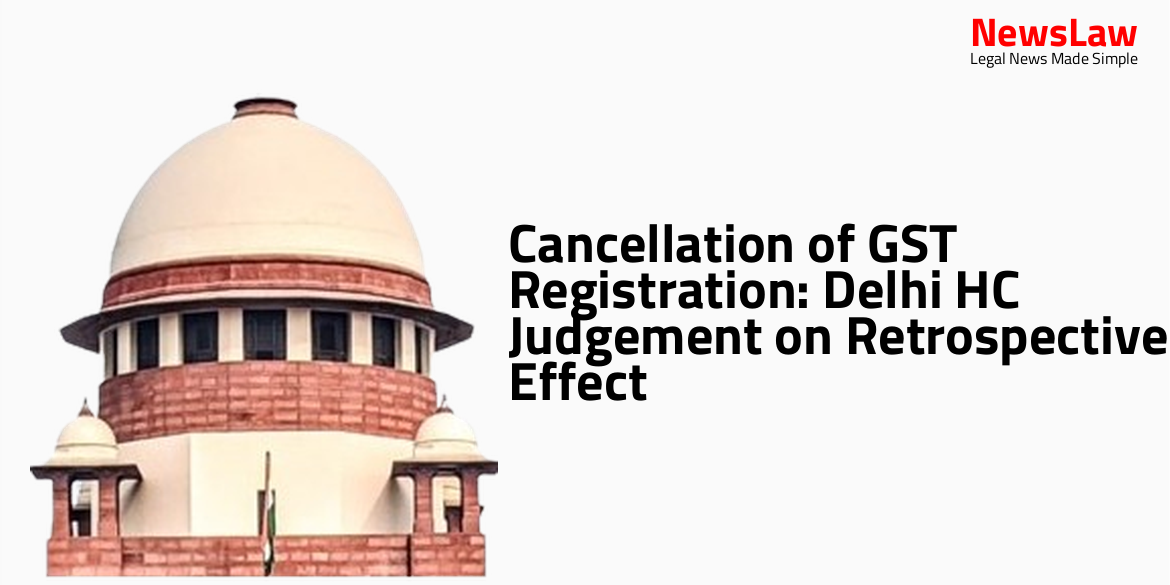Explore the nuanced legal analysis provided by the court in a recent case concerning property occupation in insolvency resolution matters. The judgment delves deep into the interpretation of statutes, agreements, and rights, shedding light on the complexities surrounding possession and development rights. Emphasizing the importance of precise language and compliance with statutory provisions, the court’s analysis navigates through the intricacies of property law within the insolvency framework.
Facts
- After the imposition of the moratorium under Section 14 of the Code, MHADA issued a termination notice to the Corporate Debtor.
- The termination notice stated that the Joint Development Agreement would stand terminated after 30 days from the date of receipt of the notice.
- The Corporate Debtor was required to hand over possession to MHADA.
- On 03.07.2018, the Appellant filed an approved Resolution Plan before the NCLT, Mumbai.
- An appeal to the NCLAT was successful in extending the CIRP period by 55 days.
- A Deed of Modification was entered into on 09.11.2011, expanding the project to a total of 47 acres of land.
- A moratorium was declared under Section 14, partially granted, excluding 38 out of 55 days.
- A Tripartite Joint Development Agreement was signed on 10.04.2008 among the Society, MHADA, and the Corporate Debtor.
- A Loan Agreement was executed on 25.03.2011 between the Union Bank of India and the Corporate Debtor.
- The Resolution Plan was approved by 86.16% of the Committee of Creditors.
- The NCLAT’s order dated 14.12.2018 omitted reference to the order dated 09.05.2018.
- NCLAT stated that 270 days had passed, making the discussion on Section 14(1)(d) irrelevant.
- Section 14(1)(d) discussion became academic due to the completion of 270 days.
Also Read: Legal Analysis on Physical Ability in Rape Case
Arguments
- The petitioner argued that the land in question belongs to the Maharashtra Housing and Area Development Authority, and has not been formally transferred to the Corporate Debtor.
- He contended that there was no ‘license to enter’ granted, emphasizing the legal distinction between possession and occupation.
- Cited various clauses and sections of the MHADA Act to support the argument that joint development schemes must have prior approval and supervision of the Authority.
- Emphasized the importance of resolving any conflict between the MHADA Act and the Insolvency Code in favor of MHADA.
- Referred to a recent judgment by Justice S. Ravindra Bhat and a Bombay High Court order to support the interpretation that Section 238 of the Code cannot be extended beyond its provisions.
- Argued that Section 14(1)(d) of the Code does not apply in this case, as the expression ‘…is occupied by’ does not align with the ownership or possession criteria set out in the section.
- Mr. Dave and Mr. Patil referred to the judgment in Sushil Kumar Agarwal vs Meenakshi Sadhu and Others regarding specific performance of development agreements
- Three categories of development agreements were mentioned in the judgment, stating that agreements where interests in property were not created cannot be specifically performed
- Section 3(27) defines ‘property’ to include various descriptions of property and interests arising out of it
- Section 14 discusses moratorium on the insolvency commencement date, prohibiting certain actions against the corporate debtor
- Section 18 outlines the duties of the interim resolution professional in the corporate insolvency resolution process
- Section 31 states the approval of the resolution plan by the Adjudicating Authority binds various stakeholders
Also Read: Legal Analysis on Admissions and Document Consideration in Insolvency Case
Analysis
- The analysis of the judgement focuses on the interpretation and application of various legal provisions and agreements in the context of eviction, possession, and development rights.
- It emphasizes the burden of proof on the landlord to establish grounds for eviction under specific laws and agreements.
- The termination of agreements, including the Joint Development Agreement, is highlighted based on non-compliance and discontinuation of activities.
- The distinction between ‘describe’ and ‘matter’ in legal terms is discussed, indicating the importance of precise language in statutes.
- Various judgments and Acts, such as the MHADA Act and Rent Control legislations, are referenced to support legal interpretations and decisions.
- The conflict between contractual agreements, insolvency resolution processes, and statutory provisions is analyzed to determine the rights of involved parties.
- The relevance of ‘occupation’ in legal terms, including physical presence and possession, is deliberated upon in relation to Joint Development Agreements and property rights.
- The necessity for adherence to statutory provisions and the resolution of disputes within the legal framework is emphasized throughout the analysis.
- Sections 76 and 79 of the statute grant MHADA important functions related to repairs and reconstruction of dilapidated buildings.
- The Board can undertake structural repairs to buildings, prioritize repairs, provide temporary accommodation, and reconstruct new buildings for housing occupants.
- The Authority can entrust the Board with executing schemes for building repairs, reconstruction, and housing schemes.
- Section 36(4) clarifies assets that are not included in the liquidation estate and are not used for recovery.
- The Joint Development Agreement grants the developer a license to demolish existing structures, construct new ones, and allot tenements.
- There is a distinction between the expressions ‘proceeding’ and ‘suit’ used in Section 22(1) of the statute.
- The absence of expansive words ‘or the like’ after the word ‘suit’ indicates a semantic difference.
- Recovery of property under Section 14(1)(d) is related to property ‘occupied by’ a corporate debtor.
- The term ‘occupied’ has been the subject of discussion in various court judgments.
- The question of subsidy receivable by the raising contractor prior to the appointed day was addressed in the context of Section 22 of the Nationalisation Act.
- The use of ‘suit’ in the amendment restricts the recovery methods for money or guarantees.
- Parliament’s deliberate choice of the word ‘suit’ in Section 22(1) limits the scope of recovery methods.
- The legislature must be taken to be aware of past interpretations of the word ‘proceeding’ when using ‘suit’ in the statute.
- The significance of both using and omitting qualifying words in different provisions of the Act should be noted.
- The distinction between suits for money recovery and proceedings for money recovery enforced by the legislature must be honored.
- The judgment is distinguishable as it does not refer to rights or interests created in property, but only physical occupation of the property.
- The ratio of the judgment indicates that Development Agreements creating an interest in property can be specifically performed.
- Section 14(1)(d) of the Insolvency & Bankruptcy Code focuses on the recovery of property that is ‘occupied’.
Also Read: Jurisdictional Clarity in Arbitration Cases
Decision
- Appeal allowed and impugned order of the NCLAT set aside
- NCLT directed to dispose of resolution professional’s application (I.A. No.21433/2018) within six weeks from today
Case Title: MR. RAJENDRA K. BHUTTA Vs. MAHARASHTRA HOUSING AND AREA DEVELOPMENT AUTHORITY AND ANR. (2020 INSC 214)
Case Number: C.A. No.-012248 / 2018



